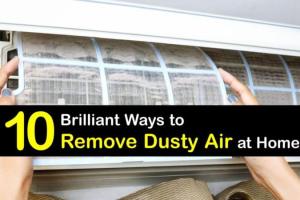Effective Ways to Clear Dust from the Air: A Comprehensive Guide

-
Quick Links:
- 1. Introduction
- 2. Understanding Dust and Its Sources
- 3. The Health Impact of Dust
- 4. Strategies to Get Dust Out of the Air
- 5. The Role of Air Purifiers
- 6. Importance of Proper Ventilation
- 7. Cleaning Tips to Reduce Dust Accumulation
- 8. Case Studies: Successful Dust Reduction
- 9. Expert Insights on Air Quality
- 10. FAQs
1. Introduction
Dust is an inevitable part of our environment. It accumulates in our homes, affecting both cleanliness and air quality. With rising concerns over indoor air pollution, understanding how to effectively remove dust from the air has become essential for health and well-being. This comprehensive guide will explore various techniques and strategies to help you achieve cleaner air in your home.
2. Understanding Dust and Its Sources
Dust is composed of tiny particles that can include dirt, pollen, human and animal hair, fabric fibers, and even insect debris. Understanding the sources of dust is crucial in managing its presence in our living spaces.
- Indoor Sources: Carpet fibers, upholstery, and curtains.
- Outdoor Sources: Pollen, soil, and pollution.
- Human Activity: Cooking, cleaning, and moving around can stir up dust.
3. The Health Impact of Dust
Dust can trigger various health problems, especially for those with allergies or respiratory issues. Exposure can lead to:
- Allergic reactions such as sneezing, itching, and rashes.
- Respiratory issues, including asthma attacks and chronic bronchitis.
- Long-term exposure can worsen heart and lung diseases.
According to the Environmental Protection Agency (EPA), indoor air can be more polluted than outdoor air, making dust management critical for health.
4. Strategies to Get Dust Out of the Air
Here, we will discuss actionable strategies that can help you effectively reduce dust levels in your home.
4.1 Regular Cleaning
Regularly cleaning your home is one of the most effective ways to minimize dust.
- Vacuuming: Use a vacuum cleaner equipped with a HEPA filter.
- Dusting: Use microfiber cloths that trap dust instead of spreading it.
- Wash Bedding: Regularly wash and dry bedding to remove dust mites.
4.2 Use of Air Filters
Installing air filters in your HVAC system can significantly reduce dust circulation in your home. High-efficiency particulate air (HEPA) filters can capture up to 99.97% of particles, including dust.
5. The Role of Air Purifiers
Air purifiers are excellent for removing dust from the air. Here are some benefits and tips for selection:
- Choose HEPA Filters: Ensure your air purifier has a HEPA filter.
- Consider Room Size: Select an air purifier that matches the size of your room.
- Regular Maintenance: Change filters as recommended to maintain efficiency.
6. Importance of Proper Ventilation
Good ventilation is crucial in reducing indoor dust levels. Here are ways to improve ventilation:
- Open Windows: When weather permits, open windows to allow fresh air in.
- Exhaust Fans: Use exhaust fans in kitchens and bathrooms to reduce humidity and dust.
7. Cleaning Tips to Reduce Dust Accumulation
Implementing specific cleaning strategies can help minimize dust buildup in the long run:
- Declutter: Reduce the number of items that can collect dust.
- Choose Hard Flooring: Consider replacing carpets with hard surfaces.
- Wash Curtains: Regularly wash or vacuum curtains and drapes.
8. Case Studies: Successful Dust Reduction
To illustrate the effectiveness of these strategies, consider the following case studies:
Case Study 1: Family with Allergies
A family with members suffering from allergies implemented a strict cleaning regime and installed HEPA air purifiers. Within a month, they reported a significant reduction in allergy symptoms and overall air quality improvement.
Case Study 2: Office Environment
An office that invested in an advanced air filtration system saw a decrease in employee sick days attributed to respiratory issues, showcasing the importance of clean air in workspaces.
9. Expert Insights on Air Quality
Experts agree that monitoring air quality is vital. Dr. Jane Smith, an environmental health expert, emphasizes, "Regularly assessing indoor air quality can help identify dust sources and mitigate health risks."
Tools like air quality monitors can provide real-time data on dust levels, helping homeowners take timely action.
10. FAQs
What is the best way to reduce dust in my home?
The best methods include regular cleaning, using air purifiers, and maintaining good ventilation.
How often should I vacuum to reduce dust?
Vacuum at least once a week, or more frequently if you have pets or allergies.
Can indoor plants help reduce dust?
Yes, certain indoor plants can help filter air pollutants, but they should not replace regular cleaning.
How do I know if my air quality is poor?
Signs include persistent allergies, respiratory issues, or visible dust accumulation. Air quality monitors can also help.
Are air purifiers worth the investment?
Yes, especially if you have allergies or live in an area with high dust levels. They significantly improve indoor air quality.
What types of air filters are most effective?
HEPA filters are the most effective for capturing dust and allergens.
How do I maintain my air purifier?
Regularly check and replace filters according to the manufacturer's recommendations.
Is it necessary to dust every day?
While daily dusting is not necessary, it’s crucial to dust high-traffic areas regularly to minimize buildup.
Can humidity levels affect dust accumulation?
Yes, high humidity can lead to more dust mites, while low humidity can cause dust to become airborne.
What is the best vacuum cleaner for dust removal?
A vacuum cleaner with a HEPA filter and strong suction is ideal for effective dust removal.
By implementing the strategies outlined in this guide, you can significantly improve the air quality in your home and reduce dust levels effectively. Regular maintenance, cleaning, and the use of technology are key to achieving a healthier living environment.